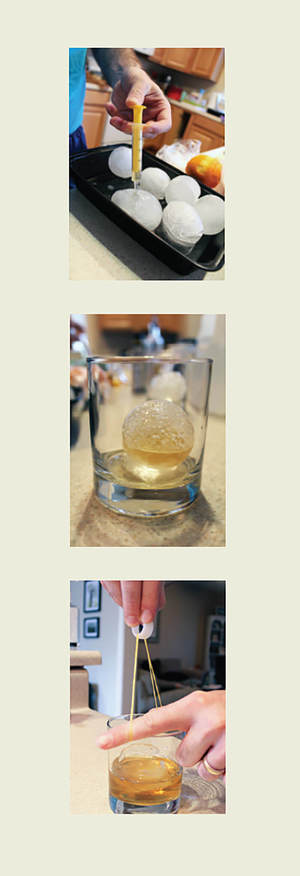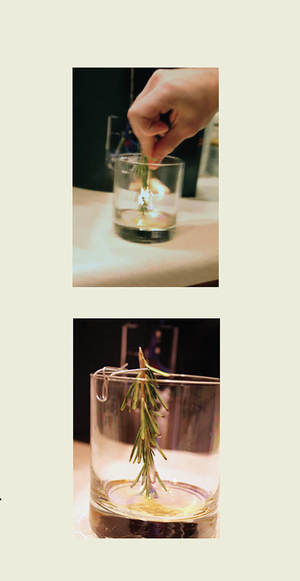
Photography by Tara Hunt McMullen ’12
I’m no bartender. I’m far more comfortable opening a bottle of wine than shaking a sidecar, if that’s even how you make a sidecar. But when writing about The Aviary Cocktail Book and its creators, I deemed it my journalistic duty to recreate a cocktail from said book.
For those who know anything about The Aviary in Chicago, little is straightforward, most especially the drinks. They might come served in a treasure chest or a pipe. They might contain curry or chilies or popcorn. And they seem to bend the laws of reality.
Some of the famed Chicago bar’s most extraordinary concoctions are served “in the rocks” — funneled into a hollow sphere of ice that a patron would break open with a small slingshot. Aviary Cocktail co-author Allen Hemberger ’01 assured me that the lemon-sized spheres are easier to fashion than they appear, so my husband and I decided to give them a [bartender pun] shot. One Sunday night we put our infant in her bouncer seat so she could watch as we filled water balloons and prepared an ice bath in a Tupperware container. We poked and prodded the balloons, trying to get them cold before submerging them in cups of icy whiskey.
The whiskey comes with a story. Fighter pilots like my husband, Trent McMullen ’12, are known to keep a bottle of Jeremiah Weed, a 90-proof distillation of liquid fire, in their homes for those moments when someone might visit and want a drink. I’ve been warned that not having a bottle on hand carries consequences.
This particular bottle has occupied prized real estate in our freezer for four years now, and no one has ever requested a drink because, according to the mouthy former-fighter-pilot band Dos Gringos, it tastes like “something in between Lysol and alcohol and a touch of gasoline.”
So when the recipe called for “cheap liquor,” I seized the opportunity to use it for our experiment: We needed a lower freezing point, and alcohol provides a colder bath than ice water. When the balloons are dipped into the alcohol, they develop an icy shell. The book says it should firm up in 5 1/2 minutes. Our balloons sat for a few hours. Once they were ready, I carefully sliced the balloons open, revealing ice spheres with water inside. I was giddy . . . until they disintegrated in my hand.
Two crumbled into an icy slush. One had frozen solid. Another cracked down the center in a gaping seam. But two held together, so into each I drilled a small hole through which to drain the water and then inject the cocktail using a syringe that came with my daughter’s baby Tylenol.
Per the book’s suggestion, we had made a straight-up Old Fashioned, a drink Trent frequently fixes at home, and chilled it on ice. We grabbed a rubber band and a plastic coupler from a cake-decorating kit so he could shoot the cube open à la The Aviary. But the moment we funneled the cold cocktail into the ice sphere as it sat in a highball glass, the shell began to crack and melt. Trent’s point-blank shot made a satisfying “thud,” but the ball didn’t really crack open. Instead, it slowly dissolved and leaked the drink into the glass. It tasted fine, but the moment lacked the theatrical climax we desired.

Round Two was an attempt at “On a Wire,” an autumnal apple-cider drink used to extinguish a burning sprig of rosemary. To make the required graham-cracker syrup, I was able to jury-rig a sous vide machine using a pot of steaming water, a wooden spatula and a Ziploc bag. The apple-cider ice cubes were no problem once I gathered all the necessary spices, and the steeping of the cider made our kitchen smell delightfully like fall.
Two days later, once the cubes were frozen and the syrup was chilled, we added them to a cocktail shaker along with cognac and aperitifs and bitters. Then we prepared our glass. We poured a half ounce of slightly warmed brandy into the bottom and set up a sprig of rosemary with a bent paperclip.
We probably should have heeded the call for a small sprig of rosemary, because when we ignited the brandy to toast our moderately sized sprig, the fire ran up the stem like a cartoon TNT fuse into a burst of blue flame and a potent waft of the herb.
Then we followed the instruction to douse the flame with the shaken cocktail, but when the icy mixture hit the blazing brandy, the glass popped and cracked. We stared at the shattered glass with gaping mouths, then at one another, then back at the drink, before breaking into a peal of nervous laughter. An even greater failure on our part. We tried again without the fire, but the drink lost its signature smoky rosemary flavor.
But here’s the takeaway: For three days we pushed beyond our normal evening routine to try something new and learned quite a bit in the process. Neither of us had ever tried cognac, which we’ve learned is distilled white wine. We dug into the differences between Campari and Aperol, read about how bitters are made and discussed the importance of garnishes. In short, the episode reignited our curiosity in the kitchen.
It also reminded us that we, like Allen and his wife and fellow Aviary Cocktail contributor Sarah Hemberger ’05, like to learn, but we had settled into a rut since having a baby. The experience was a jump-start back into projects we had tabled — if at a slower pace than before.
As for the book, many recipes would stretch rookie bartenders, but several seem achievable. We plan to concoct the Fresno chili margarita and the strawberry-Lapsang souchong Old Fashioned, and believe we can do so with more success.
The book is also a great conversation starter. Guests are constantly perusing it and asking questions about the drinks, the bar and the creators. Most think we’re mad for attempting the recipes, and they might be right, but we’ve had a lot of fun in the process.
Tara Hunt McMullen is a freelance writer and a former associate editor of this magazine.